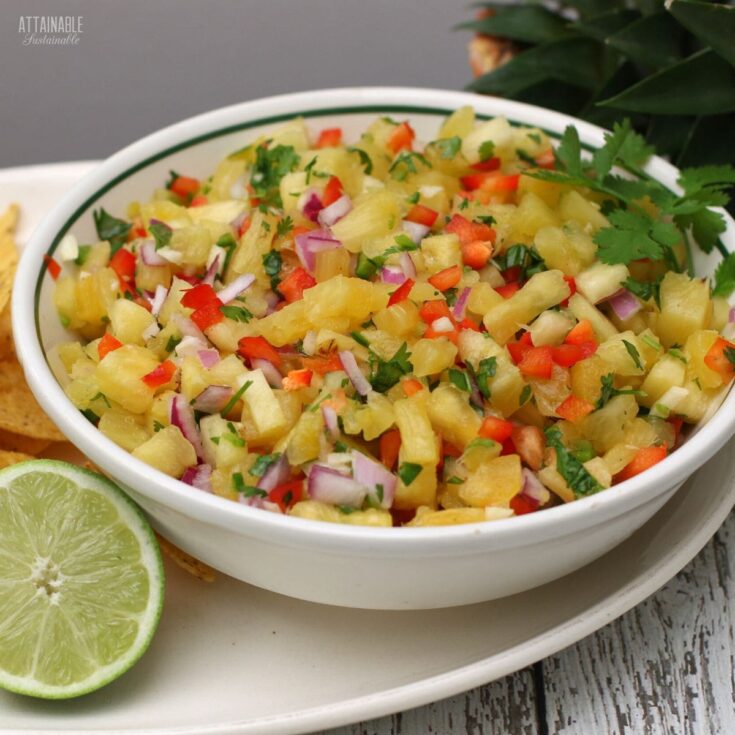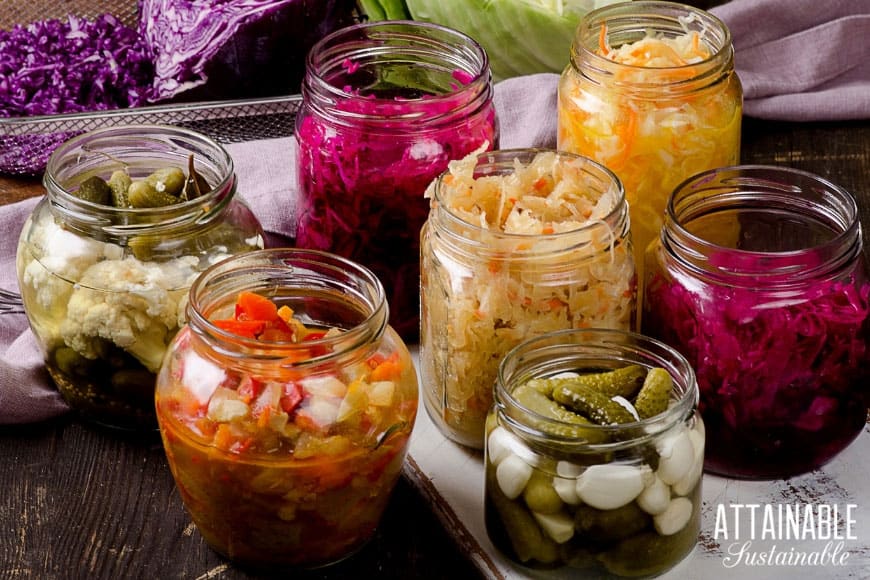As someone who loves to experiment with new recipes, I am always on the lookout for unique and flavourful dishes. One of my recent favourites is fermented pineapple salsa.
This delicious dish combines the sweet taste of fresh pineapple with a tangy and spicy kick, making it perfect for any occasion.
If you are interested in trying out this recipe yourself, then keep reading!
In this article, I will be sharing my easy-to-follow guide on how to make fermented pineapple salsa at home.
Ingredients To Make Fermented Pineapple Salsa

Before I start cooking, I always gather all the necessary ingredients.
Here’s what you’ll need:
- 1 whole pineapple (peeled and diced)
- 1 red onion (diced)
- 1 jalapeño pepper (seeded and diced)
- 3 cloves of garlic (minced)
- 1/4 cup of cilantro (chopped)
- 1 tablespoon of sea salt
- 1 tablespoon of honey
- 1/4 cup of whey (optional)
All these ingredients can easily be found at your local grocery store or farmer’s market.
Once you have everything, it’s time to get started!
Preparation
Before I start cooking, I like to prepare all my ingredients.
I peel and dice the pineapple, dice the red onion, seed and dice the jalapeño pepper, and mince the garlic.
I also chopped the cilantro and set it aside.
Next, I mix the sea salt and honey together in a small bowl.
If I have whey, I add it to the mixture as well.
This will be used to ferment the salsa.
Fermentation
Fermenting the salsa not only adds flavour, but it also increases its nutritional value.
The whey contains probiotics that help with digestion, and the fermentation process breaks down the pineapple’s enzymes, making it easier to digest.
Once everything is prepared, I mix all the ingredients together in a large bowl.
I then transfer the mixture to a quart-sized mason jar and pour the salt and honey mixture over it.
I make sure to leave about an inch of space at the top of the jar to allow for expansion during fermentation.
It’s important to use a jar with an airtight lid to prevent oxygen from getting in and spoiling the salsa.
I also place the jar on a plate to catch any overflow during fermentation.
I then cover the jar with a lid and let it sit at room temperature for 2-3 days.
During this time, I burp the jar once a day by opening the lid to release any built-up gases.
It’s important to keep an eye on the salsa during fermentation.
If it starts to smell bad or mould appears, it’s best to discard it and start over.
Mix Everything Together
The first step in making fermented pineapple salsa is mixing together all the ingredients.
Combine the diced pineapple, red onion, jalapeño pepper, minced garlic, chopped cilantro, sea salt, and honey in a large bowl.
Evenly Distributed Ingredients
Make sure that all the ingredients are evenly distributed throughout the mixture.
You want each bite to have a balance of sweetness, spiciness, and tanginess.
Did you know that fermented foods are rich in probiotics, which are beneficial for gut health?
Chill and Ferment
After mixing the ingredients, cover the bowl with a lid or plastic wrap and let it sit at room temperature for a few hours.
Then, transfer the mixture to a jar and let it ferment in the refrigerator for a few days.
⇒Fermenting the salsa not only adds flavour but also increases its nutritional value.
Enjoy Your Salsa
Once the salsa is fermented, it’s ready to be enjoyed!
Serve it with tortilla chips, on top of tacos, or as a side dish to your favourite Mexican meal.
Add Whey (Optional)

If you want to speed up the fermentation process, you can add whey to your salsa.
Whey is the liquid that separates from yoghurt or kefir when it’s strained, and it contains beneficial bacteria that will help ferment your salsa faster.
How to Add Whey
To add whey to your salsa, simply pour 1/4 cup of whey over the mixture and stir everything together.
⇒Whey is a great source of probiotics that can help improve gut health.
Benefits of Adding Whey
Adding whey to your salsa can help speed up the fermentation process, resulting in a tangier and more flavorful salsa.
Additionally, the probiotics in whey can help improve gut health and boost the immune system.
Other Ways to Speed Up Fermentation
If you don’t have whey on hand, you can also add a tablespoon of sea salt to your salsa to help speed up the fermentation process.
Another option is to use a starter culture, which can be purchased online or at health food stores.
⇒Using a starter culture can help ensure a consistent and successful fermentation process.
Ferment Your Salsa
After mixing all the ingredients together, it’s time to start the fermentation process.
There are two ways to do this: with a fermentation weight or without one.
Using a Fermentation Weight
If you have a fermentation weight, place it on top of the salsa to keep everything submerged in its own juices.
This will prevent any mould or bad bacteria from growing on the surface.
Without a Fermentation Weight
If you don’t have a fermentation weight, then use a spoon to press down on the salsa until it’s fully covered by its own juices.
You can also use a zip-lock bag filled with water as a makeshift weight.
Cover the bowl with a clean cloth or lid, and leave it at room temperature for 2-3 days.
During this time, the beneficial bacteria will break down the sugars in the pineapple and create lactic acid, which gives the salsa its tangy flavour.
Checking Your Salsa
After 2-3 days, check your salsa.
It should have a tangy smell and taste.
If it smells bad or has mould growing on the surface, then discard it and start over.
⇒Remember to always use clean utensils and bowls when fermenting your salsa. Any bad bacteria can ruin the fermentation process and make your salsa unsafe to eat.
Storing Your Salsa
Once your salsa is fermented to your liking, transfer it to a clean jar with a tight-fitting lid.
Store it in the refrigerator for up to a month.
Check Your Salsa
After 2-3 days, check your salsa to see if it’s ready.
The easiest way to tell is by looking at the bubbles on the surface.
If there are lots of small bubbles, then your salsa is ready!
Testing the Flavour
Taste a small amount of the salsa to make sure it has the right balance of flavours.
If it’s too sweet, let it ferment for another day.
If it’s too sour, then it may have fermented for too long.
Store Your Salsa
After making salsa, transfer it into a clean jar with a tight-fitting lid and refrigerate it.
This will help to keep it fresh for a longer period of time.
How to Store Fermented Pineapple Salsa
If you have made fermented pineapple salsa, it will last for several weeks in the fridge.
However, it’s best eaten within the first week or two when it’s at its freshest.
⇒If you want to keep your salsa for longer, you can freeze it. Simply transfer it to a freezer-safe container and freeze for up to 6 months.
How to Store Fresh Pineapple Salsa
If you have made fresh pineapple salsa, it’s best to consume it within a few days.
This will ensure that it’s at its freshest and most flavourful.
⇒When storing fresh pineapple salsa, make sure to keep it in an airtight container in the fridge. This will help to prevent it from spoiling too quickly.
How to Store Canned Pineapple Salsa
If you have canned your pineapple salsa, it can last for up to a year if stored properly.
Make sure to keep it in a cool, dry place away from direct sunlight.
⇒When opening a can of pineapple salsa, make sure to check for any signs of spoilage, such as a foul odour or mould. If you notice any of these signs, discard the salsa immediately.
Benefits of Fermented Foods

As someone who loves pineapple salsa, I can attest to the fact that fermented foods are not only delicious, but they also have many health benefits.
Gut Health
Fermented foods are rich in beneficial bacteria that support gut health.
These bacteria can help balance the microbiome in your gut, which can improve digestion and help your body absorb nutrients more efficiently.
Immune System and Inflammation
In addition to improving gut health, fermented foods may also boost your immune system and reduce inflammation in the body.
This is because the beneficial bacteria in fermented foods can help regulate the immune system and reduce inflammation.
Weight Loss
Believe it or not, fermented foods can even help you lose weight.
This is because they can reduce cravings and improve insulin sensitivity, which can help regulate blood sugar levels and promote weight loss.
⇒By incorporating more fermented foods into your diet, you can improve your overall health and well-being.
- Try adding fermented foods like kimchi, sauerkraut, and kefir to your meals
- Look for fermented versions of your favourite foods, like salsa and pickles
- Experiment with making your own fermented foods at home
Fruits That Can Be Fermented – Discover Now! ⇒ READ MORE
The Bottom Line:
Making fermented pineapple salsa is easy and fun, and the end result is a flavourful and nutritious dish that you can enjoy anytime.
With just a few simple ingredients and some patience, you can create a delicious snack or topping that everyone will love.
So why not give this recipe a try?
Your taste buds (and your gut) will thank you!
